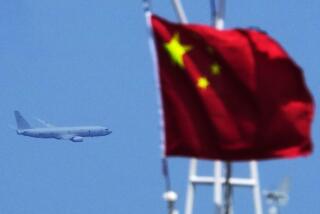TURMOIL IN CHINA: Crackdown on Dissent : China’s Underground Presses Seized as Crackdown on Media Continues
- Share via
BEIJING — “Lies written in ink can never disguise facts written in blood.”
Lu Xun, Chinese writer, 1926
Along with the pageant of arrests, interrogations, confessions and handcuffings shown night after night on state television, there have also appeared scenes of raids on printing presses in Beijing.
The machinery is shown being pulled out of dark rooms in monotonous housing projects and loaded on army trucks--another example of the relentless pursuit of “counterrevolutionaries” by security forces.
The raids are basically an effort to monopolize the spread of information. The government is trying to ensure that its version of violence during the June 3-4 assault on pro-democracy demonstrators in and around Tian An Men Square is the only one.
The state-run press is also being brought into line in a clampdown of a different sort.
Critical Reporter
During a television broadcast Monday, an announcer read a letter from a reporter criticizing notions of a free press that surfaced here in the days and weeks preceding the attack on Tian An Men.
After viewing the official version of events that have been broadcast here nonstop since June 4, the reporter repented his participation in pro-democracy rallies.
“What is freedom of the press?” he asked in his letter. “Is freedom of the press meant to be counterrevolutionary? Is freedom of the press to subvert the government? In the whole world, is there any nation that permits this kind of press freedom?
“In the United States, the media can curse the President but absolutely not overturn the government.”
The statement is evidently meant to put an end to resistance by many Chinese journalists to martial law. Some reporters had participated in anti-government demonstrations before June 3-4. During some demonstrations, the usually tight reins on television were loosened and reporters took the opportunity to show all of China unimpeded scenes from the square.
On Virtual Strike
Others have reportedly been on a virtual strike since the attack, in which the army killed hundreds, perhaps thousands of demonstrators.
The tightening of controls on the press and underground publishing will undoubtedly make it difficult for protest literature to surface in the wake of the Tian An Men killings.
In 20th-Century China, such protest writings have a history of appearing in response to similar political cataclysms--the May 4, 1919, student movement against the Qing Dynasty, for instance, and the series of student protests against the Nationalist government in the 1920s and 1930s, many of which were brutally suppressed.
This spring, many students found in their demonstrations an echo of the May 4, 1919, movement. A song written by Beijing students last month ended with the chorus:
“Hold high the banner of May 4th.
The May 4th spirit will forever live.
Uproot feudalism and bureaucracy
From the motherland!”
Often, links to such past struggles are forged by allusion, a favorite literary device employed by Chinese writers.
After the attack around Tian An Men Square and on Changan Avenue, Beijing’s main east-west thoroughfare, students at several campuses in Beijing hung banners bearing the inscription: “Blood debts must be repaid in kind.”
The slogan alluded to a line from Lu Xun, one of this century’s leading Chinese writers. He penned the words in response to a massacre of 40 anti-government student demonstrators in 1926 at the hands of the Nationalist government.
“This is not the conclusion of an incident, but a new beginning,” Lu wrote of that crackdown.
For many Chinese, the literary link to the past is as important as possession of the square itself: It is the difference between viewing the deaths of hundreds of demonstrators and their supporters as an isolated incident or seeing it as part of a temporarily frustrated but still vital tide.
However, getting rid of the printing presses will at least narrow the chances that essays, poems, and stories will circulate freely inside China.
In the past, especially after the Democracy Wall movement of 1979, writings published abroad kept the literature alive. Dissident words from this spring are already seeping from China into Hong Kong.
Chai Ling, a Beijing Teachers University student who was one of the leaders of the movement, sent a recording of her thoughts to Hong Kong before she went into hiding.
“What can we do to bring back those students who were sacrificed?” she wondered. “Their souls will always remain on Changan Avenue. They’ll never come back. Some of them were very, very young. They’ll never come back.”
Her words, too, also recalled protest literature past. Compare, for example, a poem by writer Wen Yiduo written after the deaths of students at Tian An Men in 1926:
“See there, whose children are those?
They’re hardly adolescents, are they?
What’s going on?
Aren’t those bayonet wounds on their heads?
By tomorrow, the city of Beijing will be full of ghosts.”
The government seems acutely aware of the significance of such allusions and has tried to separate Tian An Men, 1989, from repressions of the past. Officials insist that no one was killed on Tian An Men Square during a night of bloodshed that ended at dawn June 4. That someone might have been killed elsewhere seems not to matter. By government admission, people were killed along the length of Changan Avenue, the boulevard that cuts across the north end of the square--although the official account distinguishes between “the people,” who were killed by accident, and “thugs” and “counterrevolutionary rioters” who were gunned down in self-defense.
Any rival account is blasted as “rumor-mongering.”
Whether the Chinese believe this account may not be the point; it puts them on notice about what they are supposed to believe. Already in Beijing, people willing to discuss the Tian An Men massacre sometimes begin their replies with, “I have heard a lot of rumors.” It is one way to avoid taking a stand.
More to Read
Sign up for Essential California
The most important California stories and recommendations in your inbox every morning.
You may occasionally receive promotional content from the Los Angeles Times.










